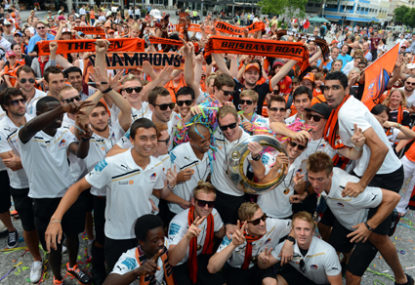It’s been largely ignored or forgotten about, but this month marks ten years since the publication of the Crawford Report, which set football in this country in a fundamentally new direction.
The fact that it has been so overlooked says a lot. Instead of fretting about the still yet to be completed aspects of the report, we were instead caught up in a gripping conclusion to the A-League season.
Which is not to say that the unfinished business is best left forgotten.
For one, the A-League is still owned and operated by the governing body, a decade after the Crawford Report and the NSL Task Force – which included NSL directors Stefan Kamasz, Remo Nogarotto and Andrew Kemeny, not to mention former Socceroos Johnny Warren, Jack Reilly and Charlie Yankos – recommended that it be operated as a separate entity.
There have been rumblings from club owners for a while now, but it seems unlikely that the FFA will loosen its grip on the A-League, and allow it to be run as a separate and independent entity.
Still, those rumblings have quietened this season, and so the issues have been put aside for a rainy day. Not the greatest strategy, but also no reason for football fans to be overwhelmed with negativity about the state of the game.
Indeed, there have been several profound changes in the game which are cause for some celebration.
Fortune, so it is said, favours the brave. After years of flat-lining, the A-League has been rewarded for several high-stakes ventures. And even the most cynical of football fans among us would have to concede that the FFA and many A-League clubs actually deserve the credit for driving this success.
Firstly, the courage of clubs to prioritise local players and coaches has been far better than in previous years. They may not all have succeeded straight away, but the fact that up and coming coaches like John Alosi, Tony Popovic and Alistair Edwards were at least given a fair go is indicative of the seachange.
Secondly, there has been a resurgence of the marquee concept. Sydney FC’s foresight and initiative looks likely to be a good piece of business, but more importantly it has won kudos from fans and widened the horizons of the rest of the competition.
Sydney now have to spend the off-season turning their seven figure gamble into a seven figure swagger.
And of course, the FFA’s foray into the most important sporting market in the country, western Sydney, has been exceptional.
After the bungled attempts at expansion, there were grave concerns that the governing body was rushing headlong into another disaster.
But as the Wanderers started winning games and people from all over western Sydney bought into the project, there was a collective sigh of relief among football fans, regardless of club colours.
The Wanderers have succeeded in creating a coherent narrative to explain their existence. Using phrases like “football comes home” and “the newest oldest club” might annoy some, but the symbolism hasn’t been lost on their legion of supporters.
They’ve got everybody convinced that they are the only club in town with community engagment programs.
It’s the power of good PR and a consistent narrative. Perception becomes reality.
In fact, this narrative has been an important part of the way we’ve discussed both the A-League and football in general this season. Intentionally or not, fans, columnists and commentators around the country are increasingly recognising the game’s history.
Take, for example, Michael Cockerill, who after almost three decades of reporting for the Sydney Morning Herald, now spends his time reminding (or educating) us about great players, coaches, clubs and moments of a bygone era.
Similarly, his colleague Andrew Howe is employed to provide us with facts and statistics that transcend league loyalties.
And all this on the FFA’s website. It would have been unfathomable in the early years of ‘new football.’
It’s an important change, with far reaching effects. Recognising the good, the bad and the ugly of our game’s history is essential to a mature football culture.
The next step is to match the symbolism with practical and tangible change, and further reach out to new frontiers.
On and off the field, football in this country is far from perfect. At the grassroots, parents still don’t get nearly enough bang for their buck, while at the pointy end, there is a World Cup bidding scandal that the FFA will have to answer for sooner or later.
Melbourne Heart are in the throes of an existential crisis, the Central Coast Mariners can’t even afford to pay their players on time and nobody has any faith in the board at Adelaide United. The Socceroos are in serious danger of not qualifying for the next World Cup, and even if they do, watching them play is about as enjoyable as pulling teeth.
Still, uneven development aside, the competition will be more visible than ever next season thanks to a new television deal and the success of this so-called ‘breakthrough season.’ I’m not sure that you can measure the legacy of a season so soon after it’s finished, but the sentiment is clear.
Despite the many problems facing the game, few could have expected football to be where it is at the moment when the Crawford Report was published a decade ago.
To properly tackle the challenges ahead, football fans and administrators deserve a brief moment to relax, celebrate and recognise what went right.





























































































